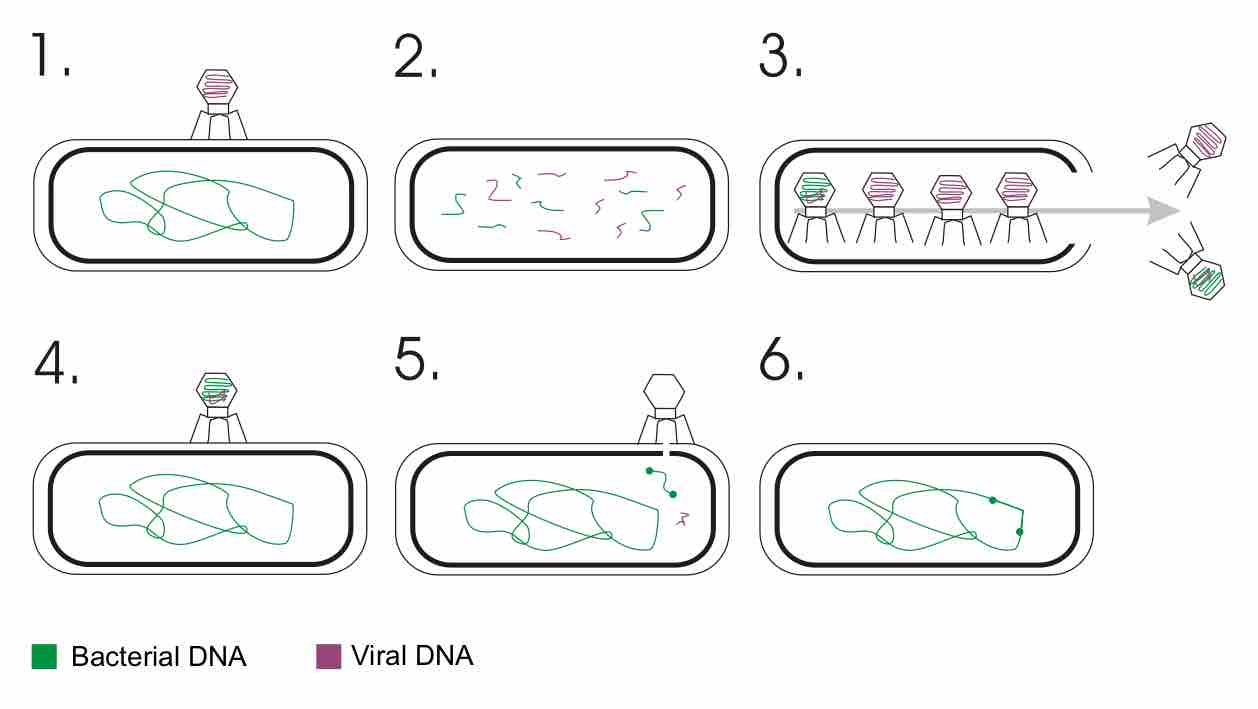Transduction
Transduction is the process by which DNA is transferred from one bacterium to another by a virus . It also refers to the process whereby foreign DNA is introduced into another cell via a viral vector. Transduction does not require physical contact between the cell donating the DNA and the cell receiving the DNA (which occurs in conjugation), and it is DNAase resistant (transformation is susceptible to DNAase). Transduction is a common tool used by molecular biologists to stably introduce a foreign gene into a host cell's genome.

Transduction
Transduction is the process by which DNA is transferred from one bacterium to another by a virus. It also refers to the process whereby foreign DNA is introduced into another cell via a viral vector.
When bacteriophages (viruses that infect bacteria) infect a bacterial cell, their normal mode of reproduction is to harness the replicational, transcriptional, and translation machinery of the host bacterial cell to make numerous virions, or complete viral particles, including the viral DNA or RNA and the protein coat.
Transduction is especially important because it explains one mechanism by which antibiotic drugs become ineffective due to the transfer of antibiotic-resistance genes between bacteria. In addition, hopes to create medical methods of genetic modification of diseases such as Duchenne/Becker Muscular Dystrophy are based on these methodologies.
The Lytic Cycle and the Lysogenic Cycle
Transduction happens through either the lytic cycle or the lysogenic cycle. If the lysogenic cycle is adopted, the phage chromosome is integrated (by covalent bonds) into the bacterial chromosome, where it can remain dormant for thousands of generations. If the lysogen is induced (by UV light for example), the phage genome is excised from the bacterial chromosome and initiates the lytic cycle, which culminates in lysis of the cell and the release of phage particles. The lytic cycle leads to the production of new phage particles which are released by lysis of the host.
Transduction is a method for transferring genetic material. The packaging of bacteriophage DNA has low fidelity and small pieces of bacterial DNA, together with the bacteriophage genome, may become packaged into the bacteriophage genome. At the same time, some phage genes are left behind in the bacterial chromosome.
There are generally three types of recombination events that can lead to this incorporation of bacterial DNA into the viral DNA, leading to two modes of recombination.
Generalized transduction is the process by which any bacterial gene may be transferred to another bacterium via a bacteriophage, and typically carries only bacterial DNA and no viral DNA. In essence, this is the packaging of bacterial DNA into a viral envelope. This may occur in two main ways, recombination and headful packaging.
If bacteriophages undertake the lytic cycle of infection upon entering a bacterium, the virus will take control of the cell's machinery for use in replicating its own viral DNA. If by chance bacterial chromosomal DNA is inserted into the viral capsid which is usually used to encapsulate the viral DNA, the mistake will lead to generalized transduction.
If the virus replicates using "headful packaging," it attempts to fill the nucleocapsid with genetic material. If the viral genome results in spare capacity, viral packaging mechanisms may incorporate bacterial genetic material into the new virion.
The new virus capsule, now loaded with part bacterial DNA, continues to infect another bacterial cell. This bacterial material may become recombined into another bacterium upon infection.
Fates of DNA Inserted into the Recipient Cell
When the new DNA is inserted into this recipient cell it can fall to one of three fates: the DNA will be absorbed by the cell and be recycled for spare parts; if the DNA was originally a plasmid, it will recirculate inside the new cell and become a plasmid again; if the new DNA matches with a homologous region of the recipient cell's chromosome, it will exchange DNA material similar to the actions in conjugation. This type of recombination is random and the amount recombined depends on the size of the virus being used.
Specialized transduction is the process by which a restricted set of bacterial genes are transferred to another bacterium. The genes that get transferred (donor genes) depend on where the phage genome is located on the chromosome. Specialized transduction occurs when the prophage excises imprecisely from the chromosome so that bacterial genes lying adjacent to the prophage are included in the excised DNA. The excised DNA is then packaged into a new virus particle, which can then deliver the DNA to a new bacterium, where the donor genes can be inserted into the recipient chromosome or remain in the cytoplasm, depending on the nature of the bacteriophage.
When the partially encapsulated phage material infects another cell and becomes a "prophage" (is covalently bonded into the infected cell's chromosome), the partially coded prophage DNA is called a "heterogenote. " Example of specialized transduction is λ phages in Escherichia coli, which was discovered by Esther Lederberg.